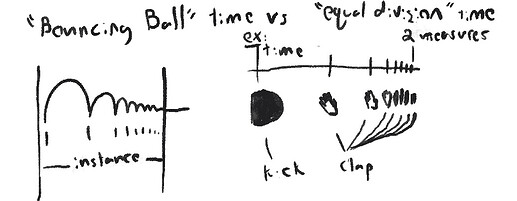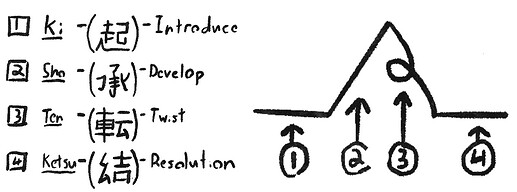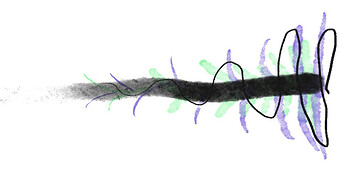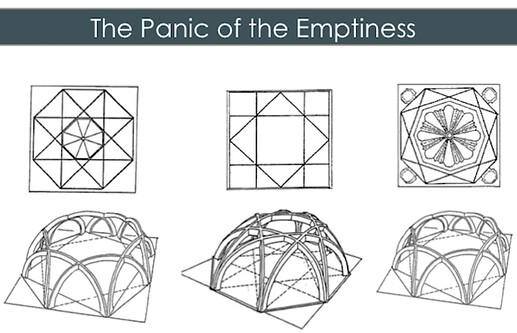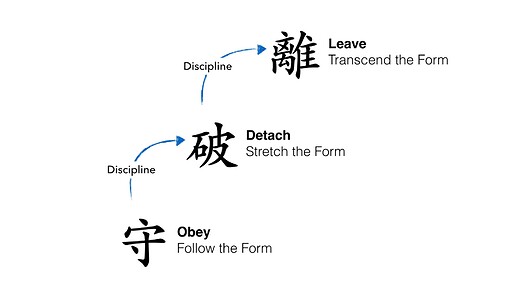1. Rhythmic Collapse
Quintessential ‘Bouncing Ball Motion’ i.e. Exponential / logarithmic decay. To be thought of as an alternative to linear (evenly spaced) time or space.
Known examples:
Visual Scene: “Angels Egg” (1985) [click image for animation]
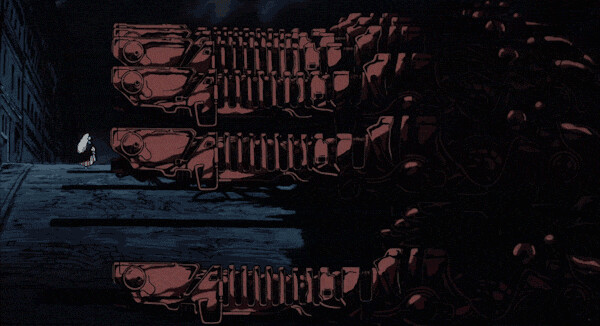
Song: “Aphex Twin - T69 Collapse”
2. Spin Dimension
Spin dimension is an attribute / property that emerges in a system, only as one part of the spin starts to act cyclically. The following example shows the ‘tabs’ for a simple drum beat. As a small fragmented section of the drum beat starts to repeat, as element such as pitch, or the cutoff of a filtering effect of the audio track would begin to modulate.
3. Completion Matrix
Any abstract thing in a creative work that requires 2 attributes to be ‘whole’, can have all it’s possibilities explored with a completion matrix. For this example, consider a simple cartoon face that requires 2 sections: eyes and mouth. We have 3 possible sets of eyes, and 3 possible sets of mouths, therefore a 3x3 matrix can be drawn, so show all 9 (3x3) possible faces that can be made. Completion matrices in this form are directly inherited from Serialist practices.
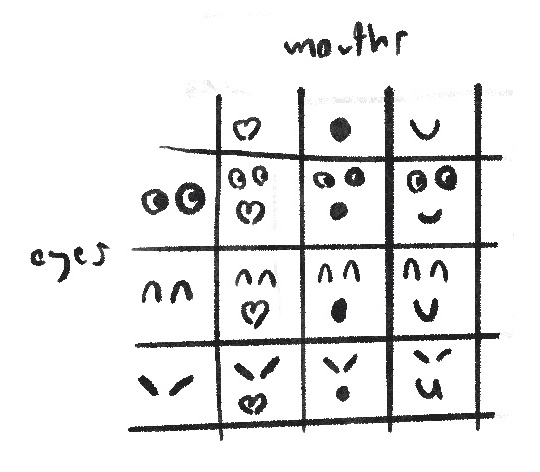
4. ‘Choose’ Function for Completeness
The ‘choose function’ (another name for the binomial theorem) can also used to explore ‘completeness’ of abstractions. Consider a doodle of a ‘braid’, made of 2 unique colors. Consider in our creative medium there are 4 colors available to us. The total number of possible ‘braids’ would then be “4 choose 2”. Typing this into any capable calculator (google can handle these requests), we are returned with the answer “6”; meaning there are 6 possible ‘braids’.
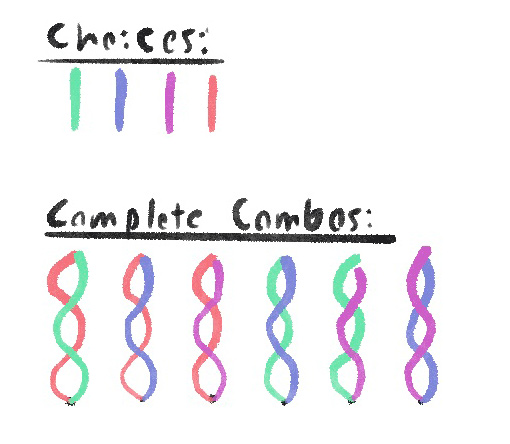
5. Number Strings
In computer science, a string is traditionally defined as (according to wikipedia):
- A sequence of characters, either as a literal constant or as some kind of variable[/size]
To use an aesthetically pleasing number string as inspiration then, is to just write out any number that in itself is appealing, and instead of considering it for it’s actual numerical value, to consider it as a sequence of symbols, that each can represent attributes or values in a structure. Additionally, the value of each digit can give an extra dimension to inspiration, in addition to acting as an ‘index’ number (as shown in example 2).
Two examples are provided below; first with converting values a number string into relative pitches in a scale, and secondly as symbolic markers in the formation of small graphically visual structures:
6. Fractal Form - Self Similar
A fractal is commonly defined as:
- [Things that] appear the same at different levels, as illustrated in successive magnifications of the Mandelbrot set. [wikipedia]
Below we can render the first few steps of one side of a Koch Snowflake, by start with the base shape (step 1), then replacing each line in the base shape with a smaller version of the base shape, and then repeating again to make a complex shape:
7. Fractal Form - Non-Self Similar
An object does not have to be self-similar to be a fractal, but simply needs to have levels of details at every scale (as opposed to the ‘calculus’ type view, that assumes things smooth out as you zoom in - great video on the subject here). A good example is the coastline line of any natural island, which is naturally infinitely jagged (arguably down to the atomic level).
The example below shows how the applying of forms to different levels or dimension can be used to construct forms similar to the self-similar method, but allowing for great creativity and diversity than forms that must be self similar.
By replacing each line in ‘Form A’ with a small version of ‘Form B’, we can start to compose a complex, non-self similar fractal form.
8. ‘Ki-sho-ten-ketsu’ [Eastern Narrative Structure]
‘Kishotenketsu’ is a 4 -part narrative or storytelling structure of eastern (Asian) tradition. It exists in juxtaposition to the typically considered (western) 5-part structure narrative structure. Unlike, western narrative, kishotenketsu is considered to not require ‘conflict’ to advance a narrative, instead relying on a dramatic ‘twist’ [ten] to move the story along.
From Wikipedia, Kishotenketsu structure is:
- Introduction (ki): introducing characters, era, and other important information for understanding the setting of the story.
- Development (shō): follows leads towards the twist in the story. Major changes do not occur.
- Twist (ten): the story turns toward an unexpected development. This is the crux of the story, the yama (ヤマ) or climax. In case of several turns in the narrative, this is the biggest one.
- Conclusion (ketsu), also called ochi (落ち) or ending, wraps up the story.
9. ‘Jo-Ha-Kyu’
According to wikipedia:
- Jo-ha-kyū (序破急) is a concept of modulation and movement applied in a wide variety of traditional Japanese arts. Roughly translated to “beginning, break, rapid”, it essentially means that all actions or efforts should begin slowly, speed up, and then end swiftly.
In essence, the principle of jo-ha-kyu encapsulates ‘rhythmic collapse’ but further generalizes the same principle of motion. The principle of jo-ha-kyu can be observed in many instances in nature, like avalanches, storms, the songs of wild birds, the hunt of a predator, and many more. It is also important and interesting to consider whether the jo-ha-kyu pattern of a phenomena repeats after it’s final stage, or does not
The example below shows a small drawing, who’s several elements increase in their intensity and frequency before abruptly halting.
10. The Panic of The Emptiness
‘Panic of the Emptiness’ is a concept introduced to me in a video presentation at the Library of Congress on Early Elements of Islamic Architecture by Saudi Architect, Rana Al Kadi [transcript].
Al Kadi describes ‘Panic of Emptiness’ as the process in which architects would create 2-dimensional geometric patterns, and then extrude them into 3-dimension space (as shown below)
My interpretation, is to consider the concept of ‘Panic of the Emptiness’ in a broader sense (than just the extrapolation from 2 physical dimensions to 3:
- Consider how the empty space of pre-existence ‘panicked’ to give rise to the big bang; how life on earth is a result of the ‘panic of emptiness’ of the universe - how life itself seems to operate from a sense of panic
- Consider how to anthropomorphism of space can shift the idea of the creative process away from ‘labor of the artist’ to a self-perputating or self-actualizing process, with the creator simply revealing or enabling instead of tasked with the role of ‘decision maker’.
- *Consider how frames or portals in a creative work can be filled with emptiness to begin with, but be put in place to guide the to process, knowing that emptiness can beget fullness leading to a complete creative work.
11. Shuhari
*Shuhari is a concept in japanese martial arts, representing a 3 step process from beginning to mastery:
- shu (守) “protect”, “obey”—traditional wisdom—learning fundamentals, techniques, heuristics, proverbs
- ha (破) “detach”, “digress”—breaking with tradition—detachment from the illusions of self
- ri (離) “leave”, “separate”—transcendence—there are no techniques or proverbs, all moves are natural, becoming one with spirit alone without clinging to forms; transcending the physical
Shuhari is an interesting and ironic reminder of most people intuitively realize about a system like ampfacts; that true masters of any sort of design can just ‘do’ without explaining, though with purpose of ampfacts being to communicate and collaborate, so we quickly see why the “the master just does and cannot explain” approach to creativity does not help us reach this goal. Computer scientist Alistair Cockburn, the creator of the ‘Agile Development Methodology’ talks about shuhari being at the core of agile. Others refer to Shuhari as a cyclic process; either way it is a good concept to reflect on as one grows creatively.
